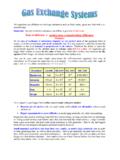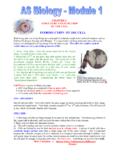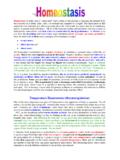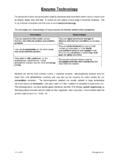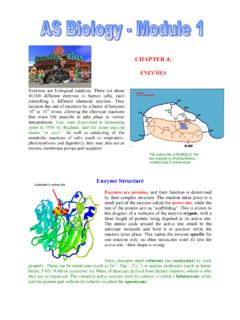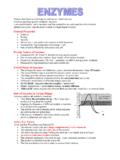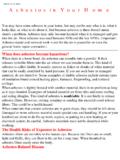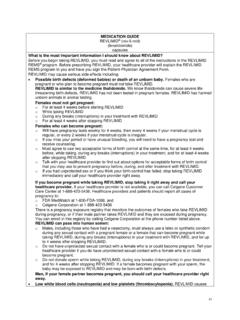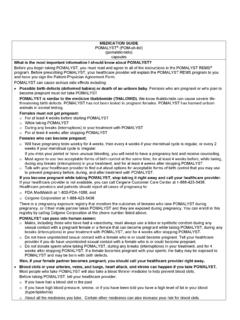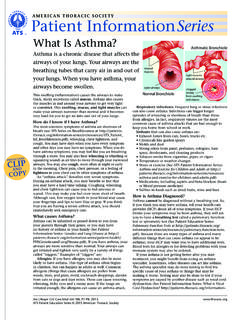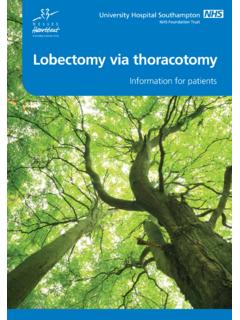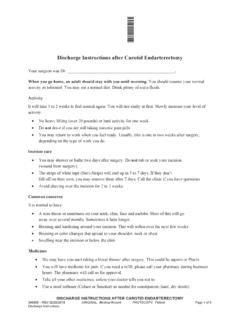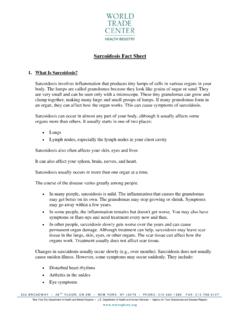Transcription of CHAPTER 5 - BREATHING - BiologyMad
1 CHAPTER 5 - BREATHING "THE RESPIRATORY SYSTEM" You have read how the blood transports oxygen from the lungs to cells and carries carbon dioxide from the cells to the lungs . It is the function of the respiratory system to transport gases to and from the circulatory system. External respiration is the exchange of gases between the atmosphere and the blood. Cellular respiration is the way that cells obtain their energy usually using oxygen to break down glucose in the cell (aerobic respiration). This Module examines the structures and mechanisms that carry oxygen to the cells for use in aerobic respiration and that eliminate the carbon dioxide that is produced as a by-product.
2 1. The function of the BREATHING system is to get oxygen into the body and waste gases out. These are involved in respiration - a vital function of all living organisms. 2. Respiration occurs at two different levels: A. The level of the cell. In the mitochondria of Eukaryotic cells, aerobic respiration needs O2 to break down glucose. Thus releasing CO2, water and producing large amounts of ATP in a process known as cellular respiration. B. The level of the organism. An organism must get O2 into its cells and CO2 out.
3 This is known as external respiration because the exchange of gases takes place with the external environment. In vertebrates, this involves the gases entering and leaving the animal s blood. 3. The BREATHING , or respiratory, system is a group of organs working together to bring about the exchange of O2 and CO2 with the external environment. 4. A single-celled organism living in water gets its oxygen directly from its surroundings by diffusion. The gases can easily cross the cell membrane by simple diffusion, obeying Fick s Law: Rate of diffusion Surface Area x Concentration Difference Distance (membrane thickness) 5.
4 Because unicellular and other very small organisms have a large Surface Area/Volume ratio, they do not need a respiratory system. 6. In larger, multicellular organisms, each cell consumes oxygen and produces CO2. Such organisms must have a respiratory system to ensure the effective and efficient exchange of gasses with their external environment if they are to survive. 7. The Earth s atmosphere is approximately 78% N2 and 21% O2. The remaining 1% is made up of CO2, and other trace gases. (Water vapour is also present, but in variable quantities, so is excluded from these figures) 8.
5 Humans have evolved a BREATHING system that is adapted to these concentrations of gases in the atmosphere. If the level of oxygen falls much below 15 % (at sea-level), our BREATHING system is unable to provide enough oxygen to support cellular respiration. THE PASSAGE OF AIR AND THE RESPIRATORY STRUCTURES 1. The human respiratory system comprises the: nose, nasal cavity, pharynx, larynx, trachea, bronchi, bronchioles, and alveoli (together forming the lungs ). 2. This may be divided into the upper and lower respiratory tracts. 3. The upper respiratory tract comprises all structures before the lungs ; the lower respiratory tract consists of the lungs themselves and the structures within them.
6 4. Air enters the body through the nose or mouth. 5. Air entering the nose passes into the nasal cavity, which is richly supplied with arteries, veins, and capillaries. It is these blood vessels which swell up when you have a cold, thus blocking the air passages. 6. Air passes through the nasal cavity, into the pharynx. The pharynx is the back of the mouth and serves as a passageway for both air and food. When food is swallowed, a flap of cartilage, called the epiglottis, presses down and covers the opening to the air passage (ever have food go "Down the wrong way"?)
7 7. From the pharynx, the air moves through the larynx and into the trachea, which leads directly into the lungs . 8. These passageways provide a direct connection between the outside air and some of the most delicate tissues in the body, and so these passageways must filter out dust, dirt, smoke, bacteria, and a variety of other contaminants found in air. 9. Preliminary cleaning takes place in the nose, where air is: A. Cleaned of large particles (dust, insects) B. Warmed C. Moistened before it passes on into the rest of the respiratory system. 10.
8 The trachea, bronchi and bronchioles are lined with cilia and kept moist by mucus secretions. The combination of cilia and mucus filters out solid particles from the air and warms and moistens the air, preventing damage to the delicate tissues that form the lungs . 11. The surface of the alveoli must be moist for them to function and so it is important that the air reaching them is moist to prevent their delicate membranes from drying out. 12. Similarly, their membranes would be ineffective if allowed to become too cold, so it is important that the air is warmed before it enters the lungs .
9 13. When air enters the body through the mouth, the air reaches the lungs in a less satisfactory state, so it is better to breathe through your nose than your mouth. 14. At the top of the trachea is the larynx (or Adam's Apple). Stretched across the larynx are two highly elastic folds of tissue (ligaments) called the vocal cords. Air rushing through the voice box causes the vocal cords to vibrate producing sound waves. The larynx of a baby is higher in the throat, allowing them to breathe and feed (suckle) at the same time. 15. From the larynx, the warmed, filtered and moistened air passes downward into the thoracic cavity through the trachea.
10 16. The walls of the trachea are made up of C-shaped rings of tough flexible cartilage. These rings of cartilage protect the trachea, make it flexible, and keep it from collapsing or over-expanding. They also allow the oesophagus (which is attached to the back of the trachea) to expand when a bolus of food is swallowed. 17. The epidermal cells lining the trachea produce mucus which helps to capture things still in the air (fine dust and microbes). This is swept out of the air passageway by tiny ciliary cells, into the throat, where it is swallowed. 18.
